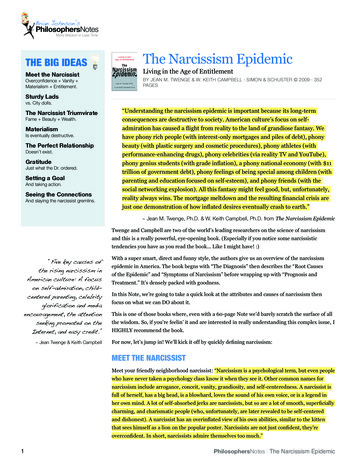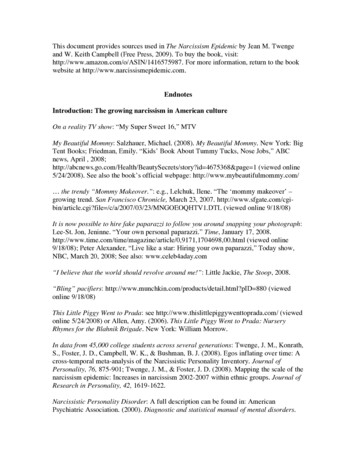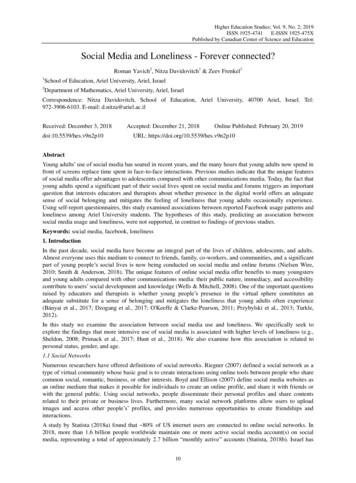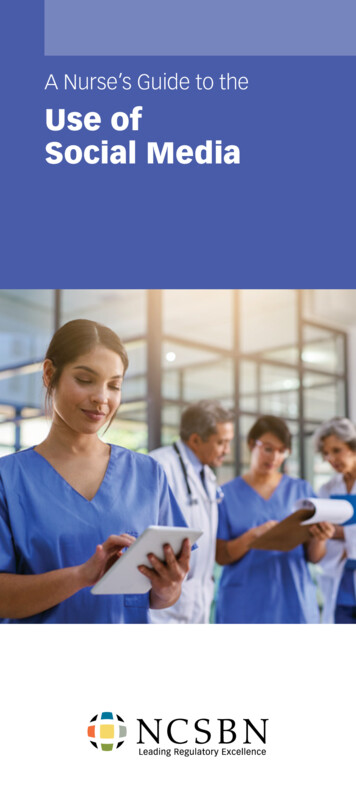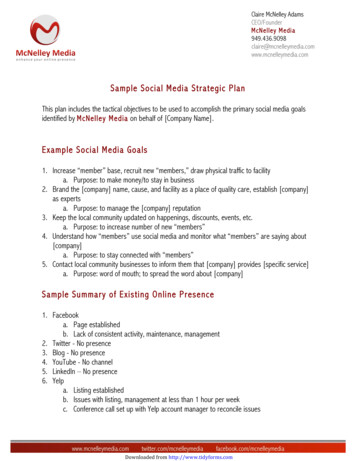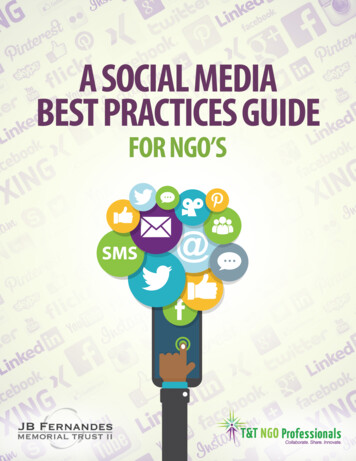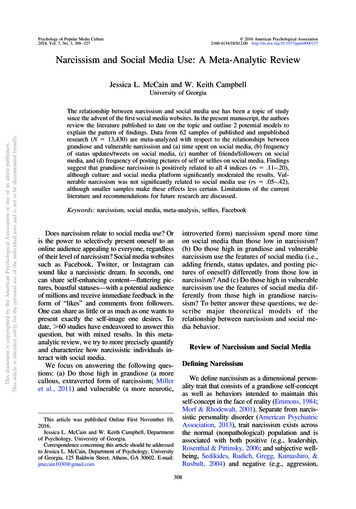
Transcription
Psychology of Popular Media Culture2018, Vol. 7, No. 3, 308 –327 2016 American Psychological Association2160-4134/18/ 12.00 http://dx.doi.org/10.1037/ppm0000137Narcissism and Social Media Use: A Meta-Analytic ReviewJessica L. McCain and W. Keith CampbellThis document is copyrighted by the American Psychological Association or one of its allied publishers.This article is intended solely for the personal use of the individual user and is not to be disseminated broadly.University of GeorgiaThe relationship between narcissism and social media use has been a topic of studysince the advent of the first social media websites. In the present manuscript, the authorsreview the literature published to date on the topic and outline 2 potential models toexplain the pattern of findings. Data from 62 samples of published and unpublishedresearch (N 13,430) are meta-analyzed with respect to the relationships betweengrandiose and vulnerable narcissism and (a) time spent on social media, (b) frequencyof status updates/tweets on social media, (c) number of friends/followers on socialmedia, and (d) frequency of posting pictures of self or selfies on social media. Findingssuggest that grandiose narcissism is positively related to all 4 indices (rs .11–.20),although culture and social media platform significantly moderated the results. Vulnerable narcissism was not significantly related to social media use (rs .05–.42),although smaller samples make these effects less certain. Limitations of the currentliterature and recommendations for future research are discussed.Keywords: narcissism, social media, meta-analysis, selfies, FacebookDoes narcissism relate to social media use? Oris the power to selectively present oneself to anonline audience appealing to everyone, regardlessof their level of narcissism? Social media websitessuch as Facebook, Twitter, or Instagram cansound like a narcissistic dream. In seconds, onecan share self-enhancing content—flattering pictures, boastful statuses—with a potential audienceof millions and receive immediate feedback in theform of “likes” and comments from followers.One can share as little or as much as one wants topresent exactly the self-image one desires. Todate, 60 studies have endeavored to answer thisquestion, but with mixed results. In this metaanalytic review, we try to more precisely quantifyand characterize how narcissistic individuals interact with social media.We focus on answering the following questions: (a) Do those high in grandiose (a morecallous, extraverted form of narcissism; Milleret al., 2011) and vulnerable (a more neurotic,This article was published Online First November 10,2016.Jessica L. McCain and W. Keith Campbell, Departmentof Psychology, University of Georgia.Correspondence concerning this article should be addressedto Jessica L. McCain, Department of Psychology, Universityof Georgia, 125 Baldwin Street, Athens, GA 30602. E-mail:jmccain1030@gmail.comintroverted form) narcissism spend more timeon social media than those low in narcissism?(b) Do those high in grandiose and vulnerablenarcissism use the features of social media (i.e.,adding friends, status updates, and posting pictures of oneself) differently from those low innarcissism? And (c) Do those high in vulnerablenarcissism use the features of social media differently from those high in grandiose narcissism? To better answer these questions, we describe major theoretical models of therelationship between narcissism and social media behavior.Review of Narcissism and Social MediaDefining NarcissismWe define narcissism as a dimensional personality trait that consists of a grandiose self-conceptas well as behaviors intended to maintain thisself-concept in the face of reality (Emmons, 1984;Morf & Rhodewalt, 2001). Separate from narcissistic personality disorder (American PsychiatricAssociation, 2013), trait narcissism exists acrossthe normal (nonpathological) population and isassociated with both positive (e.g., leadership,Rosenthal & Pittinsky, 2006; and subjective wellbeing, Sedikides, Rudich, Gregg, Kumashiro, &Rusbult, 2004) and negative (e.g., aggression,308
This document is copyrighted by the American Psychological Association or one of its allied publishers.This article is intended solely for the personal use of the individual user and is not to be disseminated broadly.NARCISSISM AND SOCIAL MEDIABushman & Baumeister, 1998; and low commitment in relationships, Campbell & Foster, 2002)outcomes. Narcissists—a term we use as a shorthand for those as scoring higher on inventories ofnarcissistic personality—are known to seek outattention and praise, and because their larger-thanlife self-views are often in conflict with reality,narcissists employ interpersonal strategies such asbragging (Buss & Chiodo, 1991), affiliating withhigh-status others (Campbell, 1999; Horton &Sedikides, 2009), and other self-promotional behaviors as well as intrapersonal strategies such asdownward social comparison (Campbell, Reeder,Sedikides, & Elliot, 2000) and self-serving attributions (Rhodewalt & Morf, 1998) to maintainhigh self-esteem. The origins of narcissism areunknown, but some theorists suggest it may be anoutgrowth of personal trauma (Pinsky & Young,2009; Young & Pinsky, 2006).Narcissism has two forms that have been studied in the literature, grandiose and vulnerable(Cain, Pincus, & Ansell, 2008). Grandiose narcissism is the extraverted, grandiose and callousform of narcissism. It also is the form that hasgarnered the most research attention. Vulnerablenarcissism is the more introverted, neurotic formthat is less well studied (Miller et al., 2011). Thisdistinction in the literature between grandiose andvulnerable narcissism shares some parallels withFreud’s (1914/1957) distinction between primaryand secondary narcissism. In Freud’s model, primary narcissism was the basic self-love experienced by the typical child. With development,much of this primary narcissism was then projected onto the representation of another person(“an object”), an image of the self, or it withdrawnback into the self, such as in the case of delusionsof grandeur coupled with psychological withdrawal. Each of these are “secondary” narcissismbecause they follow from the primary narcissism.Given this, grandiose narcissism conceptuallysuggests some residual primary narcissism butalso can reflect some secondary narcissism as psychic energy is attached or “cathected” to the selfimage. Vulnerable narcissism, however, conceptually linked to secondary narcissism, as it is alsocharacterized by low self-esteem and withdrawalin the form of social introversion (Hendin &Cheek, 1997). Although this link between grandiose and vulnerable narcissism and primary andsecondary narcissism has not been tested directlyin the literature (there are no existing measures ofprimary and secondary narcissism), there are mea-309sures of primary and secondary psychopathy andthese do correlate more with grandiose and vulnerable narcissism, respectively (Miller et al.,2010). In the present meta-analysis, we differentiate between grandiose and vulnerable narcissism, rather than primary and secondary narcissism, as is done in the literature.Narcissism is increasingly considered a featureof modern society (Twenge & Campbell, 2009)and of recent generations (Twenge, 2007). Narcissism scores have been shown to be increasingover time (Twenge, Campbell, & Gentile, 2012;Twenge, Konrath, Foster, Campbell, & Bushman,2008; cf. Grijalva et al., 2015), and popular mediaoften credits this trend for the popularity of socialmedia websites such as Facebook, Twitter, andInstagram (Diller, 2015; NPR Staff, 2015), although there is not solid empirical evidence for thelatter. These media platforms allow individuals tobroadcast information about themselves to a wideaudience at any given time— ostensibly appealingto people’s growing desire for attention andpraise— but they also can provide opportunitiesfor other needs such as belongingness, which isbelieved to be a universal need (Baumeister &Leary, 1995) and to be increasingly lacking in ourmodern society (Putnam, 2001). Narcissism canoperate at a cultural as well as individual level,resulting not only in the increase in individualtraits such as narcissism and contingent self-worthbut also in the social acceptability of related behaviors (e.g., contingent self-esteem leading toposting more pictures on social media; Stefanone,Lackaff, & Rosen, 2011). However, the data inthis review do not speak to narcissism as a culturalvariable, and thus our focus will be on the relationship between individual narcissism and socialmedia use.Theoretical Models Relating ElevatedSocial Media Use Among ThoseHigh in NarcissismThere are three general classes of theoreticalmodels that predict elevated social media use onthe part of narcissistic individuals. We refer tothese as: self-enhancement, fit, and trait models.According to the self-enhancement model (Buffardi, 2011; Campbell, 1999; Morf & Rhodewalt, 2001), social media can be a useful platform for promoting and enhancing the self(Buffardi & Campbell, 2008), so narcissisticindividuals will be drawn to social media to
This document is copyrighted by the American Psychological Association or one of its allied publishers.This article is intended solely for the personal use of the individual user and is not to be disseminated broadly.310MCCAIN AND CAMPBELLfulfill self-enhancement needs. For example, thedynamic self-regulatory processing model ofnarcissism (Morf & Rhodewalt, 2001) conceptualizes narcissism as having a goal of selfesteem regulation or self-enhancement. In orderto maintain an unrealistically grandiose sense ofself, narcissists must engage in interpersonalstrategies to obtain self-affirming feedbackfrom their environment. Similarly, the agencymodel of narcissism (Campbell, Brunell, & Finkel, 2006; Campbell & Foster, 2007) describesnarcissism as a system of mutually reinforcingtraits, skills, and behaviors that is selfsustaining but has no overarching goal. Thisconceptualization suggests that the narcissisticpatterns of behavior seen on social media comeabout because of favorable conditions that trigger and are conducive to narcissism. Social media will be “sticky” for narcissistic individualsbecause once involved the narcissistic individual will find a reasonably favorable environment for gaining admiration and esteem andgenerally reinforcing the narcissistic self.A second model is a fit model. Essentially,social media encourages wide but shallow social networks that are a good fit for narcissisticskills and abilities. For example, individualshigh in grandiose narcissism are known to prefer emotionally shallow social relationships andlike to publicly associate themselves with highstatus others (Campbell, 1999). They makegood first impressions (Back, Schmukle, & Egloff, 2010; Paulhus, 1998) and are often seen asmore attractive (Holtzman & Strube, 2010;Vazire, Naumann, Rentfrow, & Gosling, 2008).Likewise, because narcissists enjoy having social influence, they tend to occupy more centralpositions in their social networks (Clifton,Turkheimer, & Oltmanns, 2009). Given thisalong with the finding that having more attractive friends on your Facebook page gives observers a positive impression (Tong, Van DerHeide, Langwell, & Walther, 2008), it is reasonable that grandiose narcissism is consistently associated with having more friends onsocial media sites (Davenport, Bergman, Bergman, & Fearrington, 2014; Garcia & Sikström,2014).Finally, the basic personality traits associatedwith narcissism suggest a trait model of narcissism. In Big Five terms, grandiose narcissism iscomposed of high extraversion and opennessand low agreeableness (Miller et al., 2011), andextraverts have been shown to have larger socialnetworks in general (Pollet, Roberts, & Dunbar,2011; Roberts, Wilson, Fedurek, & Dunbar,2008) and spend more time and generate morecontent on social media sites (Gosling, Augustine, Vazire, Holtzman, & Gaddis, 2011). Thus,narcissists’ tendency to have more friends andgenerate more content on social media may, inpart, be linked their extraversion. In contrast,vulnerable narcissism is associated with lowagreeableness and neuroticism, which suggestsmore anxiety or discomfort associated with social media use. In basic motivational terms, wesee a similar pattern. For example, the Unmitigated Approach Model (Campbell et al., 2006;Foster & Trimm, 2008) describes grandiose narcissists as much more sensitive to and motivatedby potential reward than by potential punishment. This creates a tendency toward approachoriented social behavior (Foster, Misra, &Reidy, 2009), which may explain why thosehigh in grandiose narcissism generate more content (Buffardi & Campbell, 2008; Mehdizadeh,2010; Poon & Leung, 2011)— especially selfpromoting content (Buffardi & Campbell, 2008;Mehdizadeh, 2010)—with relatively little concern for privacy (Smith, Mendez, & White,2014; Utz & Kramer, 2009) on social mediasites. In contrast, vulnerable narcissists, who arehigh in both approach and avoidance motivation(Foster & Trimm, 2008), are more cautiousabout obtaining praise, showing more concernfor privacy (Ahn, Kwolek, & Bowman, 2015)and putting more effort into impression management (i.e., taking multiple selfies beforepicking one and cropping and editing pictures)than grandiose narcissists (McCain et al., 2016).This suggests that traits associated with grandiose narcissism are perhaps a better fit for socialmedia than those associated with vulnerablenarcissism.Findings and Potential ModeratorsDoes narcissism truly lead to more socialmedia use, and do those high in narcissism usesocial media differently than those low in narcissism? Despite the theoretical reasons to expect such differences, findings have been mixedwith regards to whether narcissists do (Fox &Rooney, 2015; Vieth & Kommers, 2014) or donot (Bergman, Fearrington, Davenport, & Bergman, 2011; Buffardi & Campbell, 2008) spend
This document is copyrighted by the American Psychological Association or one of its allied publishers.This article is intended solely for the personal use of the individual user and is not to be disseminated broadly.NARCISSISM AND SOCIAL MEDIAsignificantly more time on social media websites than nonnarcissists. This variability suggests that the effect size is small, or that thereare moderators of the effects that have not beenuncovered. Thus, our review looks at severalpotential theoretical moderators: birth cohort(i.e., the generation a participant belongs to,which presumably shares a particular set ofsociocultural experiences; see Caspi, 1987),culture, and platform. These are discussed below. We also examined other potential moderators such as age and gender composition of thesample.Birth cohort. Age differences in the relationship between narcissism and social mediause could reflect either generational or developmental effects (we do not have sufficient crosslagged data to tease these two apart). In terms ofgenerations, the research on narcissism and social media in the United States focuses primarily on two different generations. Gen Xers, whowould correspond to the MTurk samples in thisreview, are primarily in their 30s and 40s. InGen Xers narcissism has been shown to beassociated with Facebook use (Davenport et al.,2014), particularly the superiority (Panek, Nardis, & Konrath, 2013), vanity, exhibitionism,and exploitativeness (Leung, 2013) facets ofnarcissism. Millennials, or Generation Y, areprimarily in their 20s and have lived an Internetsaturated existence for most of their lives (Tapscott, 1998; Twenge, 2007). Studies often findno relationship between narcissism and socialmedia use in this generation (Bergman et al.,2011; Davenport et al., 2014; Leung, 2013),although Panek et al. (2013) found a relationship between the superiority facet of narcissismand Twitter use as well as between the exhibitionism facet and Facebook use in college students. These differences, however, could alsobe the result of development. It is plausible thatself-enhancing type behaviors on social media(e.g., selfies) are more a product of social normsin younger samples but become more stronglyassociated with personality in older individuals.Culture. Narcissism’s inconsistent relationship to social media usage may also be dueto cultural differences. First, there is ample evidence that narcissism differs in both prevalenceand presentation across cultures. Cultures thatare high in individualism (Hofstede, 1980),such as the United States, value individual autonomy more highly than cultures high in col-311lectivism, such as cultures in Asia (see Oyserman, Coon, & Kemmelmeier, 2002 for a reviewof individualism/collectivism across countries).Individualistic countries show higher levels ofnarcissism than collectivistic countries (Foster,Keith Campbell, & Twenge, 2003), with Chinaas a possible exception (Miller et al., 2015), andnarcissistic behaviors such as self-enhancementmanifest differently in collectivistic culturesthan in individualistic ones (i.e., individuals incollectivistic cultures self-enhance on communal rather than agentic traits; Sedikides, Gaertner, & Toguchi, 2003). Some researchers evensuggest that narcissism itself may manifest in acommunal rather than agentic form in collectivistic countries (Gebauer, Sedikides, Verplanken, & Maio, 2012). Second, social media usagehas been shown to differ between collectivisticand individualistic cultures. For example,United States samples have been found to differfrom Asian samples (e.g., Korean, Taiwanese,and Chinese) on the number of friends listed(Alhabash, Park, Kononova, Chiang, & Wise,2012), topics discussed (Fong & Burton, 2008),and motivations reported (Kim, Sohn, & Choi,2011) for using social media. In addition, Longand Zhang (2014) found independent selfconstrual (which is prevalent in individualisticcultures; Markus & Kitayama, 1991) to relate todifferences between British (individualistic)and Japanese samples in motivations for socialmedia use. Third, structural and political differences across countries such as technologicaladvancement, access to the Internet, wealth, andcensorship and/or control of Internet contentcan also produce differences in media usageacross countries (see Bolton et al., 2013 for areview).Platform. Although many studies focus onsocial media use as a whole, meaningful differences have been found between platforms. Thevast majority of studies in this review usedFacebook for data collection. However, Facebook may differ from other sites in importantways. For example, Facebook is considered anonymous (as opposed to anonymous) site because users are required to use their real namesand subscribe to networks which are regionallyor institutionally bound (Zhao, Grasmuck, &Martin, 2008), and Facebook censors contentthat is potentially offensive. Twitter providesslightly more anonymity, allowing users to postunder a pseudonym or handle, while forums
This document is copyrighted by the American Psychological Association or one of its allied publishers.This article is intended solely for the personal use of the individual user and is not to be disseminated broadly.312MCCAIN AND CAMPBELLsuch as 4chan and Reddit make anonymity andfreedom of content posting a priority. Thesedifferences may translate to differing relationships between narcissism and social media usage. For example, Facebook and Twitter havebeen found to differ in the facets of narcissismthat drive use (Davenport et al., 2014; Panek etal., 2013). More specifically, college studentshigh in the superiority facet preferred Twitter,whereas those high in exhibitionism preferredFacebook. However, adults (or Gen Xer’s) highin superiority preferred Facebook.The Present ResearchOur goal in the present research is to estimatethe association between narcissism (both grandiose and vulnerable) and social media use. Welooked at four key markers of social media use,including time spent on social media, frequencyof status updates, number of friends, and number of pictures of self and/or selfies uploaded.The outcome variables used in the presentresearch, including network size, communication (e.g., photo sharing, status updates), andtime spent online, were examined for both practical and theoretical reasons. From a practicalperspective, this work was a meta-analysis, sowe were limited to outcome variables whichwere in the published literature and in sufficientnumbers. The variables we studied were thusthe ones that were available.From a more theoretical perspective of socialnetwork sites activity, these variables also tapinto important constructs in the literature. Research on social networks can come from twoprimary directions. In more formal/mathematical network analysis, variables like size, centrality, edges, structure, clustering, and so forthare key to understanding the network (Eubank,Kumar, Marathe, Srinivasan, & Wang, 2004;Handcock, Raftery, & Tantrum, 2007; Kumar,Novak, & Tomkins, 2010). In specific terms ofsocial relationships in social networks, thesecan be divided into “similarities” (e.g., gender,group membership), “social relations” (e.g.,friendships, likes), “interactions” (e.g., helping,harming), and “flows” (e.g., information; Borgatti, Mehra, Brass, & Labianca, 2009).The work on social networks sites examinedin the present research is more limited becauseit does not include statistical social networkanalysis of the social networks involved. In-stead, it relies on individual level-data, typicallyindividuals reporting their own experiences insocial networks. Thus, the literature has developed to capture items important to network behaviors from an individual rather than networkperspective. Along these lines, network size iscrucial to how broad a network an individualhas which is linked to social capital (Ellison,Steinfield, & Lampe, 2007). Communicationsuch as sharing selfies and status updates is animportant marker of information flow on networks. Time spent of the network is one measure of engagement. Of course, there are othermeasures that could be used in research onsocial media. In our meta-analytic review, wewere limited to items that were used multipletimes in the literature.A second theoretical point is worth making.In the case of research examining narcissism,there is interest in variables that are theoretically linked to self-enhancement. On social network sites, these include breadth of network(breadth a larger audience for self-promotion), image and photo sharing (again, in theinterest of self-promotion), and time on the network (more time more opportunity to selfpromote; Buffardi & Campbell, 2008; McCainet al., 2016). In sum, the variables chosen involve a practical consideration of what is in theliterature, a theoretical consideration of whatsocial network properties and activities are important, and an additional theoretical consideration of what social network properties andactivities are plausible linked to narcissism.In addition to the above indicators, we alsolooked at theoretically relevant moderatorswhen possible, such as age, world region, andsocial media platform. We also test standardmoderators such as gender, nature of the data(self-report vs. objective), type of sample (i.e.,student, Mturk, or Internet), and type of narcissism measure used. Given the evidence for potential moderators reviewed above, we predictthat a random effects model will best representthe data—that is, that the effect sizes are notsampled from a uniform distribution of effects.Our basic prediction is that grandiose narcissism will be positively associated with the spectrum of social media use with small to moderateeffect sizes. We do not expect a similar effectfor vulnerable narcissism although the literatureis scarce, so our prediction is not well justified.
NARCISSISM AND SOCIAL MEDIAWe do not have specific predictions for thevarious moderators.This document is copyrighted by the American Psychological Association or one of its allied publishers.This article is intended solely for the personal use of the individual user and is not to be disseminated broadly.MethodIn order to quantify and test the link betweennarcissism and social media, we meta-analytically combined effect sizes from 62 samplesfrom 29 papers (N 13,430) for which effectsize information for select indices was available. These studies are indicated in the reference section with an asterisk (ⴱ) and include 23published works, four dissertations, one conference paper, and one set of unpublished data.Articles were searched on both the GoogleScholar and EBSCO PsycINFO databases usingthe search terms “narcissism,” “social media,”and “Facebook.” Any articles published beforeor during 2015 with reported effect sizes for therelevant indices were retained. In addition, unpublished data were solicited via a post on theSociety for Personality and Social Psychologyforums. Unpublished data sets were obtainedeither through this posting or through word ofmouth. The large majority of these studies focused exclusively on grandiose narcissism andFacebook. Thus, the present paper speaks moststrongly toward the relationship between grandiose narcissism (as measured by the Narcissistic Personality Inventory [NPI]) and Facebookuse.The use of unpublished data is an importanttopic of debate. On one hand, peer review limitsnull findings, so using only peer reviewed datacan artificially inflate findings (McAuley,Pham, Tugwell, & Moher, 2000). On the otherhand, including non-peer-reviewed findings canpotentially reduce quality. In the medical literature (we are not aware of a similar survey inthe social sciences), the majority of metaanalysts appear to recommend including unpublished data when possible (Cook et al., 1993).We chose to include unpublished work becauseobtaining accurate effect size estimates was ofprimary importance. The social sciences are riddled with inflated and even nonexistent effectsand we wanted mitigate this risk as much aspossible (Nosek, Spies, & Motyl, 2012).We examined four outcome measures (i.e.,time spent on social media, frequency of statusupdates, number of friends, number of picturesof self and/or selfies uploaded), each of whichwas measured by at least 10 studies. We also313tested for moderation when possible. The majority of the samples measured grandiose narcissism using some version of the NPI, with33% using the 40-item version (Raskin & Terry,1988), 35% using the NPI-16 (Ames, Rose, &Anderson, 2006), and two studies using theNPI-13 (Gentile et al., 2013), and two using15-item versions (i.e., Qiu, Lin, & Leung, 2010;Schütz, Marcus, & Sellin, 2004). Althoughthree of these measures (excluding the NPI-15)have been shown to provide generally equivalent measurement of narcissism (Gentile et al.,2013), differences in the reliability of scoresproduced by these measures may add to theinconsistency of the relationship between narcissism and social media use. One study usedthe NARQ (Back et al., 2013) in lieu of the NPIto measure grandiose narcissism. In addition,two studies measured narcissism as part of theDark Triad (i.e., the trio of “dark” personalitytraits identified by researchers: narcissism, psychopathy, and Machiavellianism; Paulhus &Williams, 2002), one using the Short Dark Triad(a short measure of the Dark Triad; Jones &Paulhus, 2014) and one using the Dirty Dozen(A 12-item measure of the Dark Triad; Jonason& Webster, 2010). Although Dark Triad narcissism is usually conceptualized as grandiose narcissism (Paulhus & Williams, 2002), measuringnarcissism in the context of the Dark Triad mayalso result in differing relationships betweennarcissism and social media use. Finally, Ong etal. (2011) used the revised Narcissistic Personality Questionnaire for Children (NPQC-R; Ang& Raine, 2009) for a sample of adolescents thatmay differ slightly in their measurement of narcissism. Vulnerable narcissism in this reviewwas measured mostly with the HypersensitiveNarcissism Scale (Hendin & Cheek, 1997), although Brailovskaia and Bierhoff (2016) usedthe revised Narcissistic Inventory (Neumann &Bierhoff, 2004) and Barry and colleagues(2015) used the Pathological Narcissism Inventory (Pincus et al., 2009). We report the resultsfor grandiose and vulnerable narcissism separately.All relationships were reported in or converted to Pearson’s r correlation coefficients,which was used as our effect size statistic. Allmeta-analyses were conducted using the metafor package (Viechtbauer, 2010) in R statisticalsoftware (R Core Team, 2014).
314MCCAIN AND CAMPBELLThis document is copyrighted by the American Psychological Association or one of its allied publishers.This article is intended solely for the personal use of the individual user and is not to be disseminated broadly.Social Media MeasuresTime spent on social media. Eighteensamples measured time spent on social media.This was usually in the form of self-reportedhours spent per day browsing, posting, andreading content. This is separate from selfreported number of logins per day, which wedid not include in this analysis.Frequency of status updates. Twenty-foursamples measured frequency of status updates.This was usually in the form of self-reportednumber of times one typically updates theirstatus in a given period of time. For the majorityof studies this refers specifically to Facebookstatus updates, although for two studies focusing on Twitter, this index refers to frequency of“tweeting.”Number of friends or followers. Twentyeight samples measured number of friends onsocial media. This was usually in the form ofself-reported number of friends, although threesamples retrieved objective friend counts fromparticipants’ social media profiles.Pictures of self/selfies uploaded. Elevensamples measured the frequency with whichparticipants uploaded pictures of themselves including selfies to social media. Usually this wasin the form of the se
Dec 18, 2015 · because once involved the narcissistic individ-ual will find a reasonably favorable environ-ment for gaining admiration and esteem and generally reinforcing the narcissistic self. A second model is a fit model. Essentially, social media encourages wide but shallow so-cial networks that are a good fi
